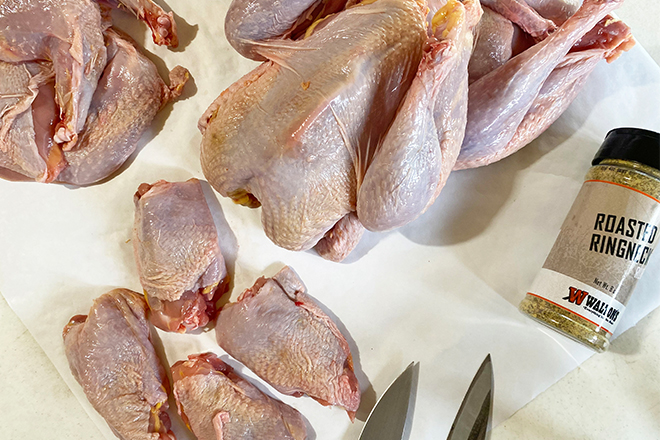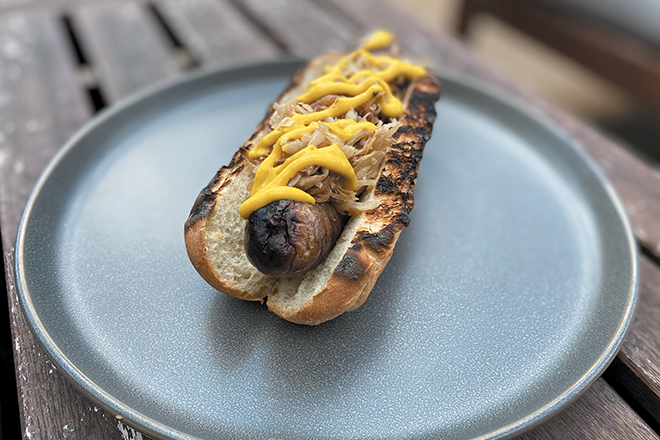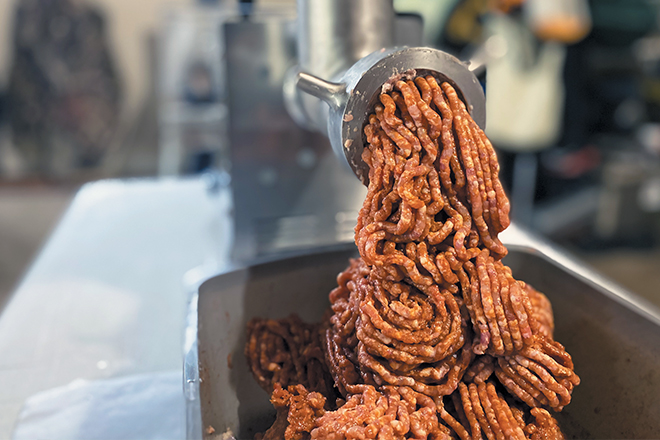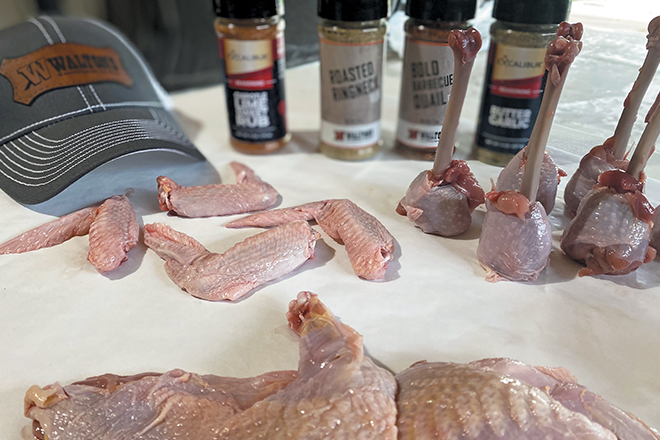
Fire up the grill and master the art of cooking upland birds over coals or flames
Story, Recipes and photos By Lukas Leaf
Skip ahead to recipes ▼
Hunters have been firing up meats over coals and open flames for millennia, learning this deep-rooted cooking style that speaks a universal language of flavor. From a campfire in the backcountry to the latest fancy pellet grill/smoker combos at home, there are plenty of ways to cook up those upland birds you work so hard in the field to harvest.
The beauty of grilling upland game birds is that you don’t have to make the process difficult. With a few simple tips and tricks, you can whip up fantastic food fit for any situation.
What I love the most about grilling is that it can be done outside during any season. Some of my fondest memories have been grilling under a tarp during a rainstorm. It only makes the event itself, and the look on the faces of friends and family as they dig in, that much more gratifying.

Breaking Down the Basics
To get started, you must be comfortable with the type of grill that you’re using. There are many options out there, so it can be challenging to make a final decision on which grill you want. The main three categories to consider are gas, charcoal and pellet. All have their advantages and disadvantages.
The charcoal grill is timeless and classic. They are easy to maintain, hold heat well, and are cheaper than gas and pellet. Once you have the coals ready, a charcoal grill will get ripping hot and ready to cook on in no time.
On the other side, propane grills can be fired up with the turn of a dial, limiting cleanup and getting those birds onto the grill faster.
Pellet grills can do it all, and most come as a combo grill/smoker, making the transition to cooking meats low and slow that much easier. The main disadvantage of pellet grills is the cost. If you’re willing to shell out the money, it’s a great option.
In the end, consider what you will be using the grill for and how often you grill. More often than not, the simpler version will do just fine.
And don’t forget: You can own and use more than one type of grill.

Stepping It Up
Aside from the grill, there is a selection of equipment that you could add to your grilling arsenal, no different than how your hunting gear collection seems to expand every year.
Smokers, grinders and sausage stuffers are great additions. A smoker is great to have if you opt to go the charcoal route for your grilling endeavors. Smokers come in many styles and sizes, and can create deep-rooted flavor while cooking meats slowly over a long time. You can buy a smoker chip box that fits easily inside the charcoal grill for a quick cost fix. It’s a great way to achieve a smoky flavor without breaking the bank.
If you’re into making sausages and burgers, then a meat grinder is a must. A small electric grinder will easily do the job if you’re not planning on grinding a ton of meat. Otherwise, a meat grinder like Walton’s #10 is fantastic and will make quick work of whatever you throw at it.
Meat grinders also come with sausage stuffer attachments. The only downfall to doing sausages this way is the speed at which the meat comes out is hard to control. Enter the sausage stuffer. With this piece of equipment, you’ll have all the control you’ll need to make sausages as good as your local butcher’s.

Techniques for Adding Flavor
Gamebirds have a reputation for coming out dryer than their domesticated chicken counterparts. So it is crucial to implement some clever techniques to ensure those birds end up moist and flavorful.
Marinating is an easy way to start, and there’s no shortage of options out there. Try making a simple oil and spice mix from what you have lying around, or grab a couple of premixed marinades from the store.
Brining is a super easy method for keeping birds moist while grilling. You can wet or dry brine.
Wet brining involves soaking the meat in a simple solution of salt, sugar and water. For game birds like pheasant, four to six hours should easily do the trick. Spruce up the brine’s flavor by adding spices and herbs, bring it to a boil, and cool the mixture before adding the meat.
Dry bringing is even easier. The meat is rubbed with kosher salt and left alone to rest in the refrigerator for a few hours. Dry brining is excellent for creating an extra crispy skin, as the salt draws moisture out while seasoning the meat entirely through.
When it comes to seasonings themselves, the sky is the limit, so it’s important to experiment and have fun. Try different pre-mixes like Walton’s Roasted Ringneck and Bold Barbequed Quail Rubs, or raid the pantry and come up with some homemade mixes of your own. Most importantly, always remember to season with salt. The best spice blend will fall flat without it.

8 Grilling Strategies & Tips
1» Always start hot when grilling. Never skimp on the heat. This notion is imperative when trying to achieve those superb, charred grill marks. It’s much easier to let the grill cool down and adjust after.
2» If the meat is not ready to turn and sticks to the grill, then it’s not ready to be touched. Let the grill do the work. The meat will come off loosely, with seasoning and skin intact, when it is good and ready.
3» Keep some extra sauce or marinade on hand to baste or spread on the meat as you grill. This will add more flavor and keep the meat from drying out.
4» There’s no reason that you can’t use the entire bird. Trust me. Sure, no one likes those pesky tendons. But you can easily remove them by making a cut mid-way down the leg. This separates the tendons, and with a bit of elbow grease, they’ll pop right out. Thighs are also amazing grilled. Another simple fix is to debone the thighs and add the meat to a sausage or burger mix.
5» Grilling whole birds is an easy method for getting the most out of your harvest. Many grills have rotisserie attachments that will do the work for you, yielding a juicy, crispy bird. One of my favorite ways to cook a whole bird is spatchcocked; this technique involves cutting the backbone out so the bird can be laid flat on the grill.
6» Bone-in, skin-on or skinless? All work great but will need different treatment before grilling. For example, boneless/skinless breast filets might need a little more marinating time … and some extra love and attention while on the grill.
7» Treat white- and dark-breasted birds differently on the grill. Gamebirds such as pheasant, ruffed grouse, quail and partridge should be treated like chicken and cooked through. Gamebirds such as sharp-tailed grouse, prairie chickens and woodcock have red-breasted meat and should be cooked no further than medium; though you’ll want to cook the thighs and legs a little longer than the breasts.
8» Always keep your gamebirds’ bodies after breaking them down or after cooking the bird whole. They make excellent stock. You won’t regret it. Ever.
3 Recipe Suggestions
Marinated and Grilled Pheasant Breasts, Thighs and Lollipops
An easy, but delicious grilling favorite that features the whole bird.
Break down the pheasant or other gamebird into pieces (two breast pieces, two thighs and two lower legs) for grilling, marinate in your favorite sauce or mix (try Walton’s Butter Garlic Marinade), let the meat sit for a couple of hours, season with a spice blend or sauce, and grill to perfection.
Pulled Barbeque Gamebird Sandwiches
An upland spin on a smoking favorite sure to please at your next get-together.
This is a great recipe to incorporate some smoking into. As with most gamebirds, I marinate ahead of time using a simple brine solution for six hours. I spatchcocked the bird and smoked it at 200º for three hours with Walton’s Bold Barbequed Quail Rub. The result was pull-apart heaven. Shred the meat, mix with your favorite BBQ sauce, reheat in a cast-iron skillet, and serve on a toasted/buttered bun with pickles.
Gamebird Brats & Smoked Chorizo Sausages
A tasty favorite to enjoy while tailgating, on your next hunting trip, or in your own backyard.
- For brats & chorizo sausages:
- 60% pheasant
- 40% fatty pork trim (pork butt is a great alternative)
- cold water
- Seasoning options:
For both the brats and chorizo, I used 60 percent pheasant and 40 percent fatty pork trim. Pork butt is a great alternative. The pork adds the much-needed fat that’s essential for a great sausage. If you have skin-on birds, even better: The extra fat will help keep the brats and sausages nice and juicy.
Start by placing your grinder parts in the freezer to cool them down. Next, break down the birds and cut them into one- to two-inch chunks. Do the same with the pork trim and place it all in the freezer to firm up. This will make the grind uniform and help push the meat through the grinder.
Grind the meat through the large grind plate first. Mix your seasoning into the first grind, mix in a little cold water, and grind the meat back through the smaller grind plate. Set aside for stuffing. I followed the seasoning amount directions from Walton’s Blue Ribbon Brat and Chorizo Sausage mixes for both these recipes.
Soak hog casings in warm water to remove the heavy salt flavor. Load up the grinder’s stuffer attachment or your sausage stuffer and fill to the size that you prefer. Make sure to twist off each sausage end as you go. It’s helpful to let the sausages sit overnight in the refrigerator to dry out. The casings will have more pop to them, and the links will hold tight when you separate them before grilling.
Grill the brats until cooked through and sizzling from inside. Smoke the chorizo sausages at around 200º F for 60 to 90 minutes.
Lukas Leaf stays busy raising a family, working as executive director at Sportsmen for the Boundary Waters, and serving as lead chef at Modern Carnivore.
This story originally appeared in the Summer 2021 issue of the Pheasants Forever Journal. If you enjoyed it and would like to also see more delicious recipes in the pages of the Quail Forever Journal, become a Quail Forever member today!